Historical origin of CRM
CRM came into being more than 30 years ago, at a time when companies were beginning to focus on the need to effectively manage their customer relationships. Originally, CRM was designed as a simple database that collected key customer information. The system was designed to give sales and customer support staff an overview of who they were dealing with - for example, what the customer had bought, what they needed, or when they had last made a purchase. In addition to basic data such as contact information and address, the CRM allowed for tracking of all customer interactions, which helped staff provide better and more personal service.
What is CRM
A CRM platform is a comprehensive software solution that allows you to collect and manage customer and prospect data in one centralized location. A wide range of information can be stored within CRM, from contact details to customer behavior, business opportunities to detailed purchase history. The ultimate goal of CRM systems is to personalize the customer experience at every step of the customer journey, from first contact to repeat purchases. CRMs also help to organize the work of employees in large companies and offer enhanced features for creating marketing content. Successful CRM implementations lead to streamlined business processes, increased customer satisfaction, and increased company profitability.
However, CRM has limitations because it only works with identified customers and information is entered into it manually. It cannot handle anonymous users, such as site visitors who have not logged in. CRM systems often lack the functionality to track all customer interactions and conversations across channels, limiting their ability to support the full customer journey cycle.
The formation of the CDP in response to the growing needs of the digital world
With the rise of digital technology, businesses needed a tool that could help them track and analyze complex customer behavior across multiple channels. This led to the development of Data Management Platforms (DMPs), which allowed customers to be segmented based on their web behavior, ad tracking, or social media interactions. However, DMPs had their limits: tracking users was anonymous (without precise identification), and the cookies on which DMPs depended had a limited lifespan.
This is where the Customer Data Platform (CDP) came into play. CDP is the next step in the evolution, combining the capabilities of CRM and DMP.
What is CDP, and what is it for?
The Customer Data Platform (CDP) is an advanced tool that was created as a response to the need for a more comprehensive view of the customer. CDP can work not only with identified customers, but also with anonymous users using various identifiers such as cookies or device IDs. This means that CDP can track user behavior across different channels (web, social, email) and link this information together. While it is not entirely clear how to define a CDP, what is certain is that its inherent elements include identity resolution, a way to identify an individual user.
One of the main differences between CRM and CDP is that CDP can work with anonymous user data, whereas CRM focuses on known customers. A CDP automatically collects and consolidates data from multiple sources, allowing for a comprehensive view of the customer base and analysis of long-term customer behavior and journeys.
CDP vs. CRM: Main differences
- Working with anonymous data:
- CDP also collects data on anonymous visitors, for example, through cookies, which allows you to track their behavior on the site without needing to know their identity.
- CRM only works with identified customers, and unless it has a specific identifier, such as email or user name, it cannot store data about a specific customer.
- Cross-channel data integration:
- CDP is able to integrate data from multiple channels, including the web, social media, email campaigns, and more. This allows companies to better understand customer behavior and create a unified strategy across channels.
- CRM focuses on specific interactions, and data is entered largely based on client interaction.
- Automation and personalization:
- CDPs use data to automate marketing processes and personalize customer experiences. This allows companies to target advertising and campaigns based on precise customer behavior.
- CRM provides data on individual customers, which helps with personalized communications, but often lacks a broader analytical context.
- How data is collected
- CDP collects data automatically through code snippets and integrations, enabling detailed analysis of customer behavior across channels.
- In contrast, CRM collects data largely manually (by manual entry by sales and customer service staff), focusing on specific interactions between the company and the customer, which can limit automation and consistency of information.
When to choose CDP
CDP is suitable for companies that have a variety of data sources and need to connect them efficiently. The world's largest companies, such as Mercedes or global e-commerce players, already consider CDP as standard today. However, CDP is not for everyone. Companies that are not digitally mature enough or do not have marketing processes in place may not be able to fully leverage the potential of CDP. This tool is only valuable if a company is able to actively work with the data and integrate it into their marketing strategies.
CDP systems in Europe
In Europe, the deployment of CDP is still in its early stages, being used mainly by multinational corporations and selected large European companies. Prominent global CDP providers that also have a presence in Europe include Adobe and Salesforce, which offer their platforms for large-scale integrations and personalisation of customer experiences. Well-known examples from the region include Bloomreach (formerly Exponea), which has become particularly popular among e-shops due to its powerful personalization and optimization features. On the other hand, Meiro, which initially focused on Asian markets, is now expanding into Europe, offering analytical CDPs with an emphasis on detailed data analytics and identity solutions. And Tealium, originally created as a tag manager, has gradually profiled itself as a robust CDP that centralizes data across digital environments. While the presence of CDPs is still rare in the country, they are growing in importance and are gradually becoming key tools for efficient management and analysis of customer data for large enterprises.

image taken from grid2.com
HubSpot: CRM that overlaps with CDP features
HubSpot profiles itself as a comprehensive CRM platform that includes tools for managing marketing campaigns, sales activities, and customer support. Its key features include tracking contact-level interactions such as website traffic analytics, engagement with emails, social media, and sales process tracking. With these features, HubSpot offers some overlap into the CDP realm, especially when it comes to collecting and using data to personalize content and marketing activities.
While HubSpot lacks identity resolution functionality that is essential for a full-fledged CDP, such as merging different identifiers into a single customer profile, it does provide a number of tools for companies looking for a robust solution for managing customer interactions and personalization across channels. Because of these capabilities, HubSpot is often used as a value-added CRM system for marketing departments that need to work with detailed customer data.
Main CRM systems used in Europe:

image taken from grid2.com
Conclusion
It is important to understand that CRM and CDP are two important customer data management tools that serve different purposes. CRM focuses on managing customer relationships and tracking customer interactions, which is key to improving sales and customer support. Whereas CDP provides a holistic view of the customer by integrating data from different channels to create a single picture of customer behavior, which is useful for advanced personalization of marketing targeting and strategy development.
The choice between CRM and CDP depends on the specific needs of the business and its level of digital maturity. While CRM is ideal for managing direct contacts and improving customer relationships, CDP is valuable for companies that need to integrate and analyze data from multiple sources to better understand and personalize the customer experience. Each platform has its place in the customer data ecosystem, and the right choice can contribute significantly to the success and effectiveness of marketing strategies.
About us
Are you looking for help choosing the right CRM or CDP tool for your business? Contact the specialists at Autoarti and BizHackers (this article was written in collaboration with them). At Autoarti, we perform CRM migrations and integrations and have insight into the major software in CRM, system integration, and sales and marketing automation. We train companies in HubSpot CRM and organize training events such as the Prague HubSpot User Group. We are happy to advise and find the right solution for your business across CRM and CDP systems depending on the size of your business and your individual needs.

__________
🔗 Follow us on LinkedIn and Facebook. There we share news, interesting facts and information about our events.
__________